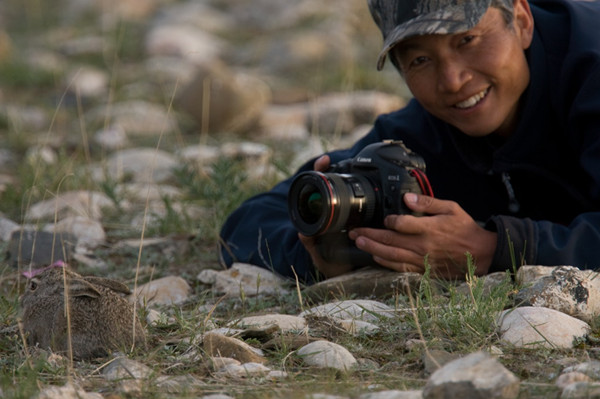Shooting for protection
- By Dolphin
 0 Comment(s)
0 Comment(s) Print
Print E-mail China Pictorial, September 4, 2013
E-mail China Pictorial, September 4, 2013
When U.S. President Bill Clinton visited China in 1998, one gift he received was a photo of a Yunnan snub-nosed monkey family: a baby in the arms of her mother, peering at the lens innocently.
|
Xi Zhinong photographs a woolly hare near the Qinghai Lake, July 2007.[Photo/Wu Lixin] |
The photo was taken by Xi Zhinong, the most famous wildlife photographer in China. A native of Yunnan Province, Xi began photographing wildlife in the late 1980s. He was the first Chinese person to win Wildlife Photographer of the Year at the Gerald Durrell Awards for Endangered Wildlife and the TVE Award at the British WildScreen Festival.
George Schaller, a famous American wildlife photographer, worked with Xi in the wild. In the foreword for Xi's photo book, Wild China, Schaller highly praised Xi's stunning images, and asserted that they will improve understanding of many species and accelerate conservation efforts.
"Watershed for Chinese Awareness of Environmental Protection"
Over two decades have passed since Xi Zhinong committed himself to photographing wildlife. "I don't remember how many photos I've taken," grinned Xi. "But one thing I know for sure: My camera has drawn me intimately close to two species, Yunnan snub-nosed monkeys and Tibetan antelopes. We've changed each other's fates."
|
Stories not to miss: |
|
• Wild China |
Xi Zhinong began working at the Yunnan Provincial Forestry Bureau in 1992, just as the Kunming Institute of Zoology under the Chinese Academy of Sciences launched a research project on Yunnan snub-nosed monkeys. Xi joined the research group in November of that year to take photos on the mountain. His first trip ended fruitlessly. Despite combing vast tracts of virgin forests, mostly above 4,000 meters high, Xi didn't take a single photo of a monkey in over a month.
He returned to the mountain with his partner in September 1993, hunting in areas he guessed the monkeys would like. One day, he came across fresh monkey droppings. "It was real, black, sparkling excrement!" recalled Xi. "I couldn't help dropping to the ground to inspect it thoroughly, admiring it like a work of art. I scanned the ground across the rocks and up to the surrounding trees. Monkey droppings were everywhere. Some were still hot and steaming. I was sure monkeys had just been there."







Go to Forum >>0 Comment(s)